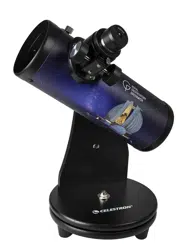Loading ...
Loading ...

ENGLISH | 3
TELESCOPE BASICS
Your telescope comes with eyepieces of different focal
lengths. Eyepieces allow you to view a magnified image in
your telescope. The smaller the focal length of the eyepiece,
the more magnification you will get with your telescope. High
power eyepieces make things appear much closer, but have
a narrower field of view, meaning you see a smaller amount
of sky. This can make it more difficult to locate small objects,
such as planets. When first trying to locate an object, use
your longest focal length eyepiece (lowest power). This will
give the widest field of view possible and will make it much
easier to find your target. Once you have the target centered
in your eyepiece, you can switch to a high power eyepiece to
get a closer view. When you are ready to find another target,
switch back to your low power eyepiece.
Sometimes local weather conditions can affect how much
magnification you can use at any given time. If you look
at bright stars with the naked eye and they appear to be
twinkling or rapidly changing color, the atmosphere is not
stable enough for sharp views under high magnification.
On nights like this, the edge of the Moon or planets may
appear as if you are viewing them through running water. If
this occurs, switch eyepieces to slightly lower magnification
and see if the image stabilizes. If it doesn’t, increase the
focal length (lowering the power) further until the view
becomes steady. The stability of images can change from
night to night and even hour by hour. For more on the effects
on seeing conditions, please see the Tips for Astronomical
Observing section (page 8).
FOCAL LENGTH OF THE EYEPIECE
MAGNIFICATION =
FOCAL LENGTH OF THE TELESCOPE
25 mm eyepiece 10 mm eyepiece
EYEPIECES & MAGNIFICATION
NOTES ON THE USE OF HIGH MAGNIFICATION
This formula can be used with any new eyepieces you decide to purchase for your telescope.
The amount of magnification an eyepiece provides with a given telescope can be calculated using this formula:
Loading ...
Loading ...
Loading ...
